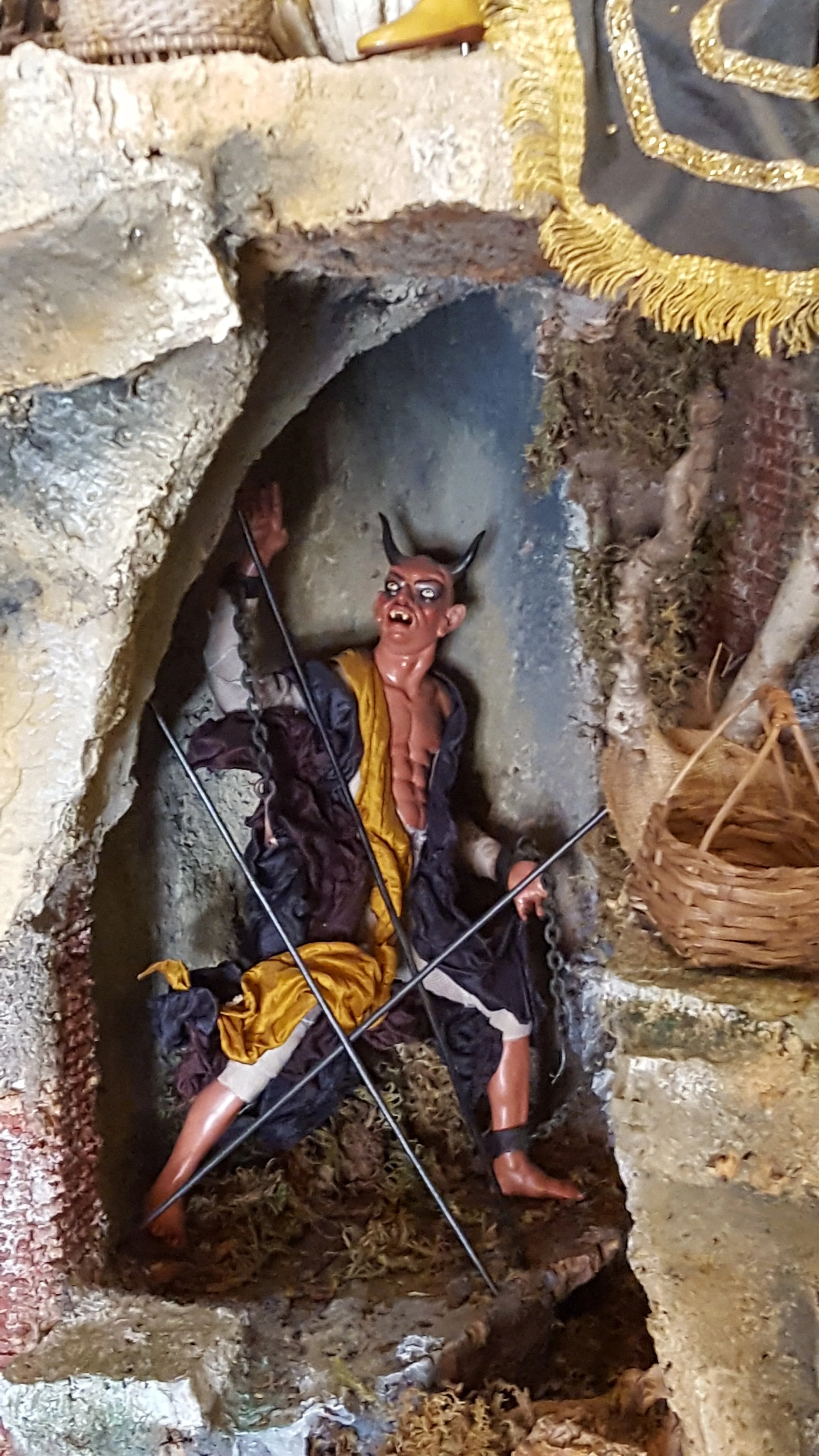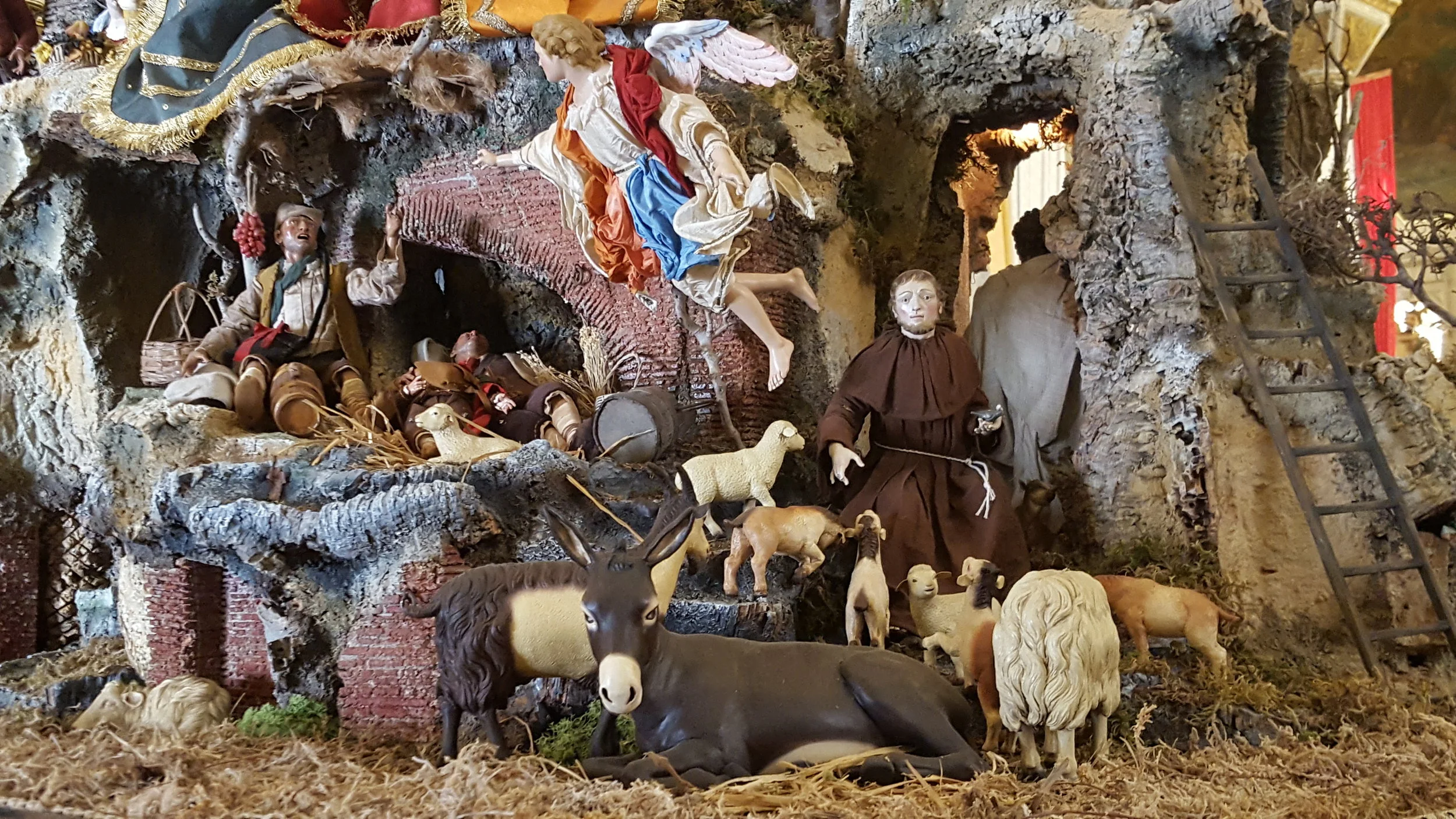Woodcut from the Nuremberg Chronicle
Background
Story
Saint Rocco (known to the anglophone world as "Saint Roch") was born in Montpellier in the 14th century to a noble family. His mother had been barren until she prayed to the Virgin Mary. Saint Rocco's birth was made all the more miraculous by a birthmark resembling a red cross on his chest.
His parents died when he was twenty years old, at which point he gave away all his worldly possessions and set out on a pilgrimage to Rome. At the time, Italy was suffering from a plague epidemic. Saint Rocco cared selflessly for the sick, effecting many miraculous cures by making the sign of the cross or laying his hands on them.
In Piacenza, however, he finally fell ill. He was driven out of town and into the forest, where he made a hut for himself out of leaves and branches. Miraculously, a spring arose near his hut to provide him with water, and a local dog began bringing him bread to eat. The dog would also lick his wounds clean, eventually healing him.
He returned to Montpellier looking like a wild man with unkempt hair and a long beard. Unrecognized by the townspeople, he was thrown in prison as a spy. He remained there for five years before dying, unwilling to reveal his identity out of humility. The townspeople recognized the birthmark across his chest, and he was venerated as a folk saint almost immediately after his death. But he was not officially canonized until the 17th century.
Heraldry
A wound on his thigh, a dog (often seen bringing him a loaf of bread), pilgrim's hat and staff
Patronage
Saint Rocco is the patron of bachelors, diseased cattle, dogs, falsely accused people, invalids, surgeons, tile-makers, gravediggers, second-hand dealers, pilgrims, and apothecaries.
He is often invoked against cholera, epidemics, knee problems, plague, and skin diseases.
Votives left for Saint Rocco at the chapel in Saint Roch Cemetery, New Orleans.
Feast day
Pilgrimage to Tolve
Twice a year, once on August 16 and again on September 16, pilgrims from throughout Southern Italy flock to the Santuario di San Rocco in Tolve, a comune in Potenza, Basilicata. Before the procession, Saint Rocco's statue is covered in the gold ex votos that his pilgrims have left for him over the years, estimated to be worth more than one million Euros. As you see in the video below, he almost seems to glow!
Pizzica Scherma in Torrepaduli
The pizzica scherma is a form of pizzica dancing in which two men mime a duel with swords either with knives or, more frequently, their fingers. Traditionally associated with the criminal underground, it is said that the dance is only taught to initiates who are presented by a compare or godfather. There are two repertoires of choreography, the leccese style and the zingaro style. Within each repertoire, the gestures made by the dancers map to a complex web of meaning.
Italian-American feasts
Saint Rocco is one of the most popular saints among Italian-Americans. One of the most famous Italian-American feasts, now in its 129th year, is held in New York by the Saint Rocco Society. I love this scene from the Godfather II, which shows what the feast was like in years past (minus, you know, the assassination bit):
Songs & Prayers
Calabrian rhythm to Saint Rocco
In this video, my teacher Alessandra Belloni demonstrates a 6/8 rhythm typically played on a snare drum in honor of Saint Rocco in Calabria:
The words "Cuncti simus concanentes" come from the Llibre Vermell de Montserrat, a collection of devotional songs from the late medieval era.
Folk song to San Rocco from Basilicata
This song is perhaps one of the most popular folk compositions dedicated to Saint Rocco. I highly recommend it for personal devotional use. If you want to sing along, you can just sing the chorus, as though you're doing call-and-response with the recording. (You can even switch "Tolve" for the name of your city, to personalize it a bit.)
Ebbiva santi Rocco, santi Rocco ebbiva,
ebbiva santi Rocco, ca ind'a Tolve stai!
Ebbiva santi Rocco, santi Rocco ebbiva,
ebbiva santi Rocco, ca ind'a Tolve stai!
'N nome di Padre Figlie e Spirte Sante,
voglio cantà 'na storia tanta galante,
'N nome di Padre Figlie e Spirte Sante,
a nome di santi Rocco i' l'accummenzo.
(chorus)
Nu iurnu in carità vuleze andà
vicino a 'nu purtone a tuppulà.
S'affaccia 'na runzella in finestrella:
«Aggi pace bell'omo questa giornata,
aggi pace bell'omo questa giornata,
ca stai lu patrune grave malate ».
« E t'aggio ditto, runzella, vinime ad aprì,
ca su se a lu malate voglio salì ».
A 'u minze di li scale foze arruàto,
lu segne la santa croce si volze fà,
lu segne la santa croce si volze fà,
ca subb'te lu malate s'avla a ozà.
(chorus)
I genti di la casa lu vulinno pagà,
e santi Rocco non si vuleva piglià:
« Si fosse pi tirnisi e pi dinare,
saria chine la fonte di lu mare.
Si fosse pi dinari e pi tirnisi,
saria chine la fonte 'u paravise ».
(chorus)
« E tu ca tini l'occhio oro e argento,
pari a vedè 'nu sante avveramente.
E tu ca tine l'occhio argento fino,
pari a vedè 'nu santo pellegrino ».
(chorus)
«Mo' ca la dignità meia èi 'nduvinata,
so' santi Rocco di Tolve pe' numinata ».
E 'n'at' a tre parole si fernesce la storia,
si ni vai santi Rocco a la gloria.
E 'n'at' a tre parole si fernesce 'u cante,
ebbiva santi Rocco e tutti i santi.
A Prayer to Saint Rocco
This prayer was shared on the website for the Santuario di San Rocco di Tolve:
English translation
O Holy God,
Father, Son,
and Holy Spirit,
by the intercession
of Saint Rocco,
our friend,
deliver us
from all illnesses,
from all sins,
and protect
our families.
Italian
O Dio Santo,
Padre, Figlio
e Spirito Santo,
per l’intercessione
di San Rocco,
nostro amico,
liberaci
da tutte le malattie,
da tutti i peccati
e proteggi
e nostre famiglie.
































